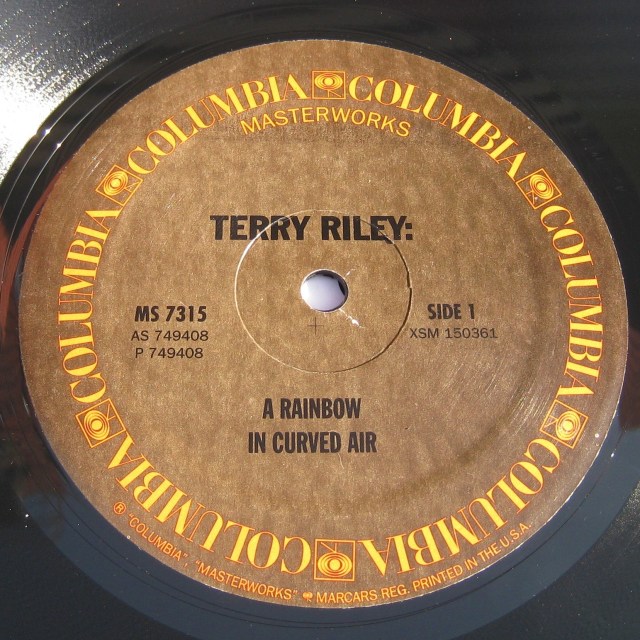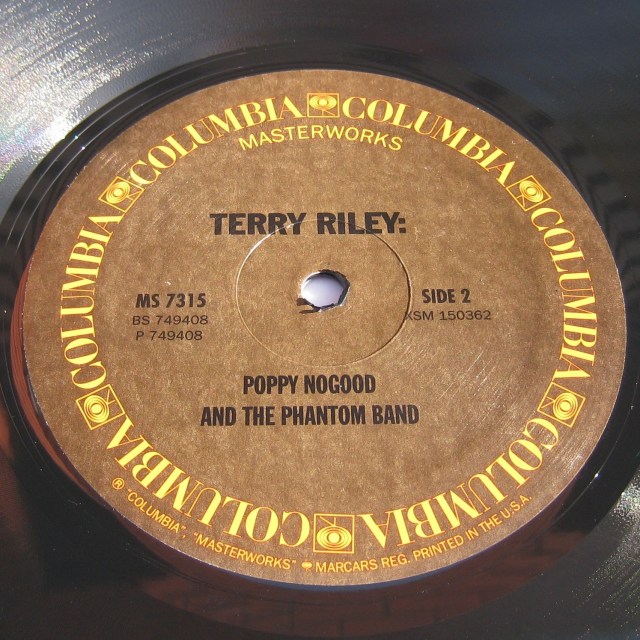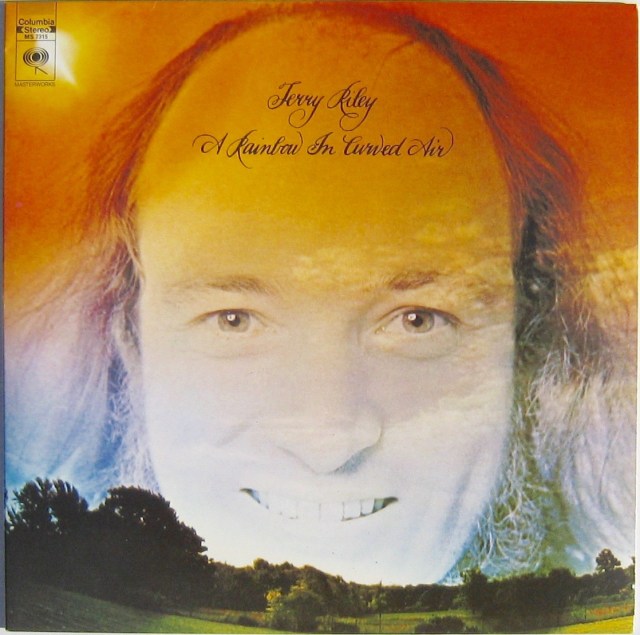From an imagined podcast…
It is generally agreed that ‘minimal music’ appeared in the mid-60s, arising out of the US avant-garde scene in which John Cage was a principal figure. Most writers and commentators, Sitsky for example, list La Monte Young, Terry Riley, Steve Reich and Philip Glass as the key composers.
A study of any discography of minimalist music will immediately reveal that La Monte Young produced few recordings. This lack of ‘catalogue’ should not suggest a concomitant lack of importance. Alex Ross lays it out clearly at the beginning of his section on West Coast Minimalism: “Minimalism proper begins with La Monte Young”. More on Young later.
For now, let us journey to the West coast of the USA, specifically California, where Terry Riley was born in June 1935. His is a much less sparse discography, headlined by his best known (and certainly most successful, sales-wise) work, A Rainbow In Curved Air.

If we accept, for a moment, the assertion of John Cage that music can be described by four characteristics,
pitch
loudness
timbre
and… d u r a t i o n …

organ notes dripping like rivulets from a broad-leafed tropical plant. quite suddenly, a spray of fast notes hits my face like a shower of rain. i’m wandering a forest of tall swaying ferns, feet crushing vegetable matter to release heady earth aromas, warmth, damp warmth, sensual and mysterious. a bird flits past, chirping a brief ecstatic welcome… the air shimmers with energy, humidity bends the light… under all, through all, the pulsing mid-range throb of the organ flurries… to a sudden stop. Silence punctuates and startles. [0:00 — 6:45, “A rainbow in curved air”]
Terry Riley met Young in the late fifties. “What La Monte introduced me to,” Riley said, “was this concept of not having to press ahead to create interest.” [Ross, p.539] This was in stark contrast to the European tradition.
Are there commonalities amongst the works produced by an array of composers? David Cope (1997) suggests qualities that may characterise minimal music:
•Silence
•Concept music
•Brevity
•Continuities: requiring slow modulation of one or more parameters
•Phase and pattern music, including repetition
…the repeated circular pulse is present but subdued. a patter of tiny feet like benign millipedes scampering over a hollow log, this dream unfolds strangely as a half-unseen path opens into a clearing where a long-haired vicar wearing love beads is playing a church organ, tribal stops fully extended, while a dozen naked maidens with painted faces dance around tapping bongos. the organ cascades, the hair swirls, synapses connect. it sounds frenzied but is more ecstatic than primal; a short organ sermon exhorts us to rise up into the air, swoop and roll on the rainbow curves, higher, higher, gone! [6:50 — 18:40, “A rainbow in curved air”]
Now if you are not sure about this music, perhaps even discovering a negative response, you are not alone. Robert Fink (2005) quotes composer Pierre Boulez as suggesting minimalism “can be understood as a kind of social pathology, as an aural sign that American audiences are primitive and uneducated.” Ouch!
Another unimpressed European was respected British writer Ian MacDonald—who many will know for his seminal work on the Beatles songbook Revolution in the Head—who claimed that minimalism is the “passionless, sexless and emotionally blank soundtrack of the Machine Age, its utopian selfishness no more than an expression of human passivity in the face of mass-production and The Bomb” [2003]. One can only wonder what it was about this music that angered him.

There is a quaint story associated the the piece that occupies side two of A Rainbow In Curved Air, “Poppy No-good and the Phantom Band”. Edward Stickland, author of Minimalism: Origins, relates it in the booklet accompanying the excellent compilation, OHM+: The early gurus of electronic music, 1948—1980.
Terry’s baby daughter Colleen (now a physician) used to call him “Poppy”, adding “Nogood” when she was piqued. The piece developed from Terry’s tape experiments of the early 60s… [Having learned the rudiments of saxophone, the resultant piece…] later evolved into “Poppy Nogood”, which appeared in various incarnations and various “All-Night flights” with dancers, light shows, mimes, and so forth.” [p. 56]
Note the different feel of this piece.
…something is fading into my brain, a quiet, slow, crescendo of quivering organ, creeping forwards in phased atonal waves like a dream of darkwater oceans. a repetitive, subdued squawking suggests a barn-full of large disconsolate birds, shuffling around seeking something they only vaguely recall. disruption. discontinuity. awake. [0:00 — 4:20, “Poppy Nogood and the Phantom Band”]
Unlike side one, where Riley is credited with playing “electric organ, electric harpsichord, rocksichord, dumbec and tambourine, “Poppy Nogood” is for soprano saxophone and electric organ. There is also lots of reverb and echo, giving the piece a shifting, dream-like quality.
… some rolling waves of organ pulse, further chirruping fades away to a drone… drifting harmonics; a plaintive brass-like call echoes over misty hills. shaman bagpipes croon to wheeling stars, it’s midnight, not dawn. echoes bounce in slow motion, the calling voice rises over but never obscures the ever-present drone. occasional low tones add a basso profundo croon… space for slow deep breaths, breath of earth and endless space…
[5:40 — 11:10, “Poppy Nogood and the Phantom Band”]
There is no question that Terry Riley courted and was embraced by the alternative culture of the 60s and 70s, performing extended concerts to chemically transported hippies and sinking himself in eastern teachings. Although it appears almost unbearably twee today, the sentiments embedded in the story on the back cover should not be despised for their naivety:
The energy from dismantled nuclear weapons provided free heat and light / World health was restored / An abundance of organic vegetables, fruits and grains was growing wild along the discarded highways
…a call, a chorus, a new dawn. hands aloft in praise, in supplication, salute. dissonant yet melded, the pace quickens with circular organ and saxophone flurries like time elapse of an unfolding flower, like an accelerated dawn that reaches midday in minutes… the pace varies, like the natural world varies, insects buzz, birds dart, cubs gambol, foliage grows before your eyes in this most psychedelic of nature documentaries. [11:10 — 21:40, “Poppy Nogood and the Phantom Band”]
Denying the organic siren-call of this music is as pointless as donning a wetsuit to take a shower. Doing so will make you frown and twitch. I wonder if Ian MacDonald might have had a different experience of minimalist music if he had taken John Lennon’s advice.
“Turn off your mind, relax, and float downstream, it is not dying”?

MUSIC
Riley, Terry (1969) A Rainbow in Curved Air. Columbia Masterworks.
Various Artists (2000) OHM+: The early gurus of electronic music, 1948—1980. Ellipsis arts, 3CD/DVD
REFERENCES
Cope, David. 1997. Techniques of the Contemporary Composer. New York, New York: Schirmer Books.
Fink, Robert (2005) Repeating ourselves: American minimal music as cultural practice. Berkeley: University of California Press, CA.
MacDonald, Ian (2003) The People’s Music. Pimlico Publishing, London, UK
Ross, A (2007) The rest is noise: listening to the twentieth century, Picador, NY.
Sitsky, L. (2002), Music of the twentieth-century avant-garde: a biocritical sourcebook, Greenwood Press, Westport, CT.
If you have got this far, then it is time to reveal that, other than the Ross book which resides on the VC music bookshelf, partially read but fully endorsed, the other quotes were sourced from a succinct and very helpful Wikipedia article (here).

Can I here shades of Percy Grainger in this? Anyway, I like it while Z has gone out to do the gardening – a child of a different revolution.
‘…today’s emerging consciousness seeks a new knowledge of what it means to be human, in order that the machine, having been built, may now be turned to human ends’
REFLECTIONS – THE GREENING OF AMERICA, The New Yorker, September 26, 1970 P. 42.
LikeLiked by 1 person
The quote you inserted certainly fits with the sentiments on the back cover of RiCA – any move towards humanism is a good thing, I reckon! Not quite sure what connection you were hearing to Perc there, DD.
LikeLike
Very interesting post. Good to see Ian MacDonald’s fabulous ‘People’s Music’ get a mention. I kind of know what he means about the most generic minimalist music, in the sense that it seems to have been co-opted by ‘corporate’ America and has become the soundtrack to any number of crap tech ads and marketing campaigns… It probably goes back to that whole Windham Hill, yuppie new age early ’80s thing.
LikeLiked by 1 person
Glad you found it interesting, Matt. Part of the reason for exploring minimalist music was my curiosity about the antecedents for Eno’s ‘Music for Airports’ which did indeed spark a wave of modern ‘easy listening’ music. Guess we cannot blame the music for its co-option by the corporate world!
LikeLiked by 1 person
Well, you’ve got me listening to Terry Riley as I type this! It’s interesting to contrast this with works by some other minimalist composers. I’m struck by the comparative lack of space, ‘A Rainbow in Curved Air’ seems to be on the go all the time! I go through phases of listening to minimalist music, my favourite works being by Steve Reich, with a sprinkling of Philip Glass. Another work with less space is John Adam’s ‘Short Ride in a Fast Machine’, which I find quite exhilarating.
I guess that minimalist music appeals to a different part of the brain than other types of music that I like, it seems more cerebral and less emotional. I’m supposedly INTJ, maybe that helps to explain my like of the genre?
LikeLiked by 1 person
It’s a while since I engaged with Myers-Briggs, ff, but I get your point. Repetition, slow but visible/aural changes, busy-ness and gradual transition. In the right mood it can be exhilarating as you say. And also curiously calming, I find. I have Reich in the background as I type…
LikeLike
Enjoyed reading this, Bruce, especially the in-between mental travelogue you provided as you listened to the pieces. Minimalist isn’t a genre I have much experience with, coming closest possibly with the stoned drone of Earth’s “Earth 2.” Back in January, I saw (“experienced” is probably a better descriptor) an ensemble performance of John Luther Adams’ “Clouds of Forgetting, Clouds of Unknowing” and Arvo Pärt’s “Fratres” — hearing such unadorned soundscapes in a reverent theater setting was certainly transportative but I’ve yet to find the pull to try it out as a more solitary activity.
LikeLiked by 1 person
And of course, sitting with others to listen (or not) and engage with the music (or not) used to be the only way to experience music until just over a century ago. Now we can have a symphony orchestra in the kitchen and death metal in the garage.
The connection with what I guess to be drone metal (?) is part of my interest, as my observation is that this music did impact ‘popular’ (as distinct from ‘art’) music directly. That’s why I chose ‘Rainbow’ as it was the first such recording to cross over.
If you stick with Rainbow (or other Riley) I’d be interested in your responses. As I type I’m listening to Reich’s ‘Music for 18 Musicians’ which I also like very much.
As always, thanks for sharing your thoughts, Victim.
LikeLike
Some more stuff here that I know very little about. Don’t shout at me but I thought the Terry Riley had similarities to ‘Tubular Bells’ for me (or I might just be saying that because I bought a copy of Thursday).
LikeLiked by 1 person
Shan’t shout, other than to gently correct your direction. Mr Riley influenced quite a few people, most likely including young Michael Oldfield. That’s actually the fun of exploring the so-called elite world of composed or ‘art’ music. There is often a trickle-down – or perhaps osmosis – effect.
LikeLiked by 1 person
My Hubner is a big fan of all this stuff. I’ve wanted to explore ‘In C’ for a long while now, especially as there is a Malian version of it too.
All really interesting stuff.
LikeLiked by 1 person
‘In C’ is certainly in that slightly dubious-sounding category called ‘seminal’. I find it quite engrossing but challenging in its own way too. The other key early minimalist work is Steve Reich’s ‘Music for 18 Musicians’ which I really like and recommend too.
LikeLiked by 1 person
To get all muso for a minute, maybe there is something a bit ‘inhuman’ about performing a lot of this stuff, from the perspective of the musician. Maybe that’s also what Ian MacDonald was getting at. I wonder if it becomes a kind of endurance test or a form of meditation for the musician. When sequencers came in around the late-’70s/early-’80s, they fitted perfectly into the minimalist musician’s mindset, so it was no accident that people like Tangerine Dream, Jean Michel Jarre and Mark Isham did some of their best stuff in that era. Maybe the sequencer is the ultimate minimalist instrument!
LikeLike
Terrific closing statement Bruce – nice to read this again a year and a bit later, with some more experience with minimalist music.
I shall not be donning any sort of wetsuit in the shower anytime soon!
LikeLike